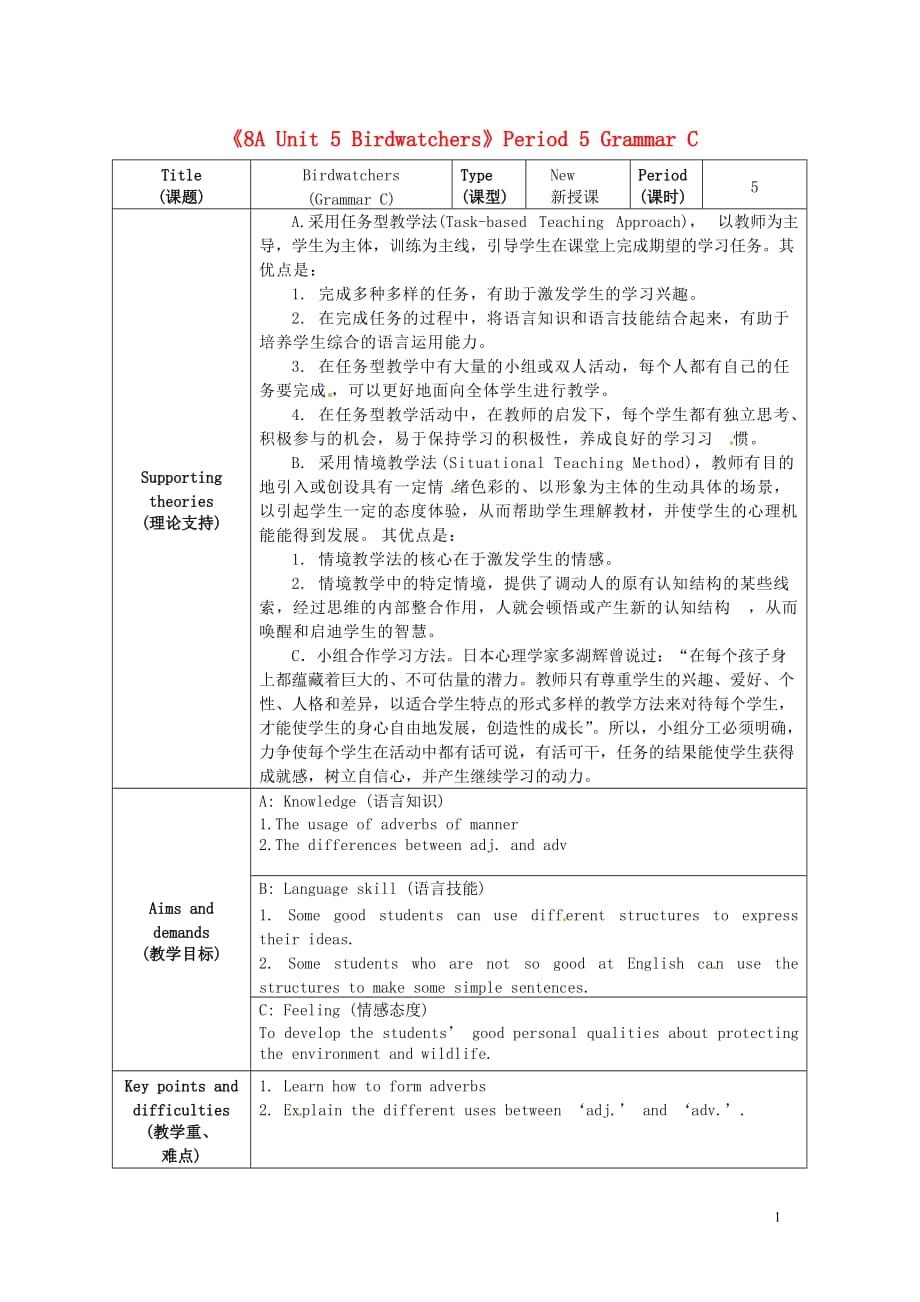《江蘇省海安縣大公初級中學八年級英語上冊《8A Unit 5 Birdwatchers》Period 5 Grammar C教案 牛津版》由會員分享��,可在線閱讀�,更多相關(guān)《江蘇省海安縣大公初級中學八年級英語上冊《8A Unit 5 Birdwatchers》Period 5 Grammar C教案 牛津版(5頁珍藏版)》請在裝配圖網(wǎng)上搜索。
1��、
《8A Unit 5 Birdwatchers》Period 5 Grammar C
Title
(課題)
Birdwatchers
(Grammar C)
Type
(課型)
New
新授課
Period
(課時)
5
Supporting theories
(理論支持)
A.采用任務(wù)型教學法(Task-based Teaching Approach)��, 以教師為主導��,學生為主體�,訓練為主線�����,引導學生在課堂上完成期望的學習任務(wù)。其優(yōu)點是:
1. 完成多種多樣的任務(wù)�,有助于激發(fā)學生的學習興趣。
2. 在完成任務(wù)的過程中�����,將語言知識和語言技能結(jié)合起來��,有助于培
2��、養(yǎng)學生綜合的語言運用能力��。
3. 在任務(wù)型教學中有大量的小組或雙人活動��,每個人都有自己的任務(wù)要完成�,可以更好地面向全體學生進行教學。
4. 在任務(wù)型教學活動中��,在教師的啟發(fā)下�����,每個學生都有獨立思考�����、積極參與的機會,易于保持學習的積極性�����,養(yǎng)成良好的學習習慣�����。
B. 采用情境教學法(Situational Teaching Method)�,教師有目的地引入或創(chuàng)設(shè)具有一定情緒色彩的、以形象為主體的生動具體的場景�,以引起學生一定的態(tài)度體驗,從而幫助學生理解教材�,并使學生的心理機能能得到發(fā)展。其優(yōu)點是:
1. 情境教學法的核心在于激發(fā)學生的情感�����。
2. 情境教學中的特定情境�,提供了調(diào)動人的原有
3�、認知結(jié)構(gòu)的某些線索,經(jīng)過思維的內(nèi)部整合作用��,人就會頓悟或產(chǎn)生新的認知結(jié)構(gòu),從而喚醒和啟迪學生的智慧�����。
C.小組合作學習方法�����。日本心理學家多湖輝曾說過:“在每個孩子身上都蘊藏著巨大的�����、不可估量的潛力�����。教師只有尊重學生的興趣�����、愛好��、個性�����、人格和差異,以適合學生特點的形式多樣的教學方法來對待每個學生�,才能使學生的身心自由地發(fā)展,創(chuàng)造性的成長”��。所以�,小組分工必須明確,力爭使每個學生在活動中都有話可說�����,有活可干�,任務(wù)的結(jié)果能使學生獲得成就感,樹立自信心��,并產(chǎn)生繼續(xù)學習的動力�����。
Aims and demands
(教學目標)
A: Knowledge (語言知識)
1.The usage o
4��、f adverbs of manner
2.The differences between adj. and adv
B: Language skill (語言技能)
1. Some good students can use different structures to express their ideas.
2. Some students who are not so good at English can use the structures to make some simple sentences.
C: Feeling (情感態(tài)度)
To develop
5�����、the students’ good personal qualities about protecting the environment and wildlife.
Key points and difficulties
(教學重��、
難點)
1. Learn how to form adverbs
2. Explain the different uses between ‘a(chǎn)dj.’ and ‘a(chǎn)dv.’.
Teaching Methods
(教學方法)
Task-based Teaching Approach
Situational Teaching Met
6��、hod
Teamwork Teaching Method
Aids:
課前準備(教具�、活動準備等)
Students:1.Review Grammar A&B. 2.Preview the new words in Grammar C, try to understand the content of Grammar C.
Teacher:1. some pictures. 3. PPT about Grammar C
教 學 設(shè) 計
課前延伸
(預(yù)習)
1. Preview the new words of this part and try t
7、o master the usage of them.
2. Finish off the exercises of this part.
Teaching Plan
(授課計劃)
Studying Plan
(學習計劃)
Aims
(設(shè)計意圖)
課
內(nèi)
探
究
課
內(nèi)
探
究
學
StepⅠWarm up & Revision
1. 以天氣和圖片做引子�����,讓
8�����、學生對圖片進行說話�����,檢查預(yù)習情況��,自然導入新內(nèi)容�。
2.小組合作學單詞,降低了學習的難度�����。
Step II Presentation
(Present the two sentences then the students summarize the word patterns.)
T: All of you did a good job. We have known something about the birds , who can describe the picture ?
S: (Picture 2) There is a nice bird in the pic
9�����、ture. The bird can sing nicely. (圖片很形象,有趣)
T: Good. What’s the adverb of ‘nice’?
S: Add-ly after ‘nice’ , that is ‘nicely’
T: Very good. Boys and girls, since we have covered Preview Part, can you sum up how to form
the adverbs of manner? (小組合作討論)
S: Work in pairs and then sum up.
1. most a
10��、djectives + ly
2. adjectives ending in le -e+y
3. adjectives ending in y -y+ily
T: Great. But with some irregular adjectives, we use the same word as the adverb,
Who would like to give us an example?
S1: (With the help of some pictures and key words.)
The bus is fast. The boy can’t r
11�����、un so fast to catch it.
(adjective: fast --- adverb: fast )
S2: …
T: And with some irregular adjectives, the adverbs are quite different. E.g. Jiang Fan is good at Maths, that’s to say: Jiang Fan does well in maths. Right?
S: Yes.
T: Then what’s the adverb of ‘good’?
S: ‘well’.
T: Very goo
12��、d. Do you know when we should use an adjective and when to use an adverb?
(屏幕給出已經(jīng)討論過的例句�����,讓學生討論�,歸納)
S: (Discuss and sum up)
--形容詞修飾名詞或放在聯(lián)系動詞之后
--副詞修飾動詞或形容詞
--當回答 ‘how’ 問句時,用副詞
Task 1: show more adjectives, let the students form their adverbs.
1.在語境中結(jié)合圖片和關(guān)
13�、鍵詞呈現(xiàn)新語言項目,有利于激發(fā)學生興趣��。
2.教師呈現(xiàn)新內(nèi)容�,學生根據(jù)已有知識采取合作、探究的方式�,總結(jié)出新的語言結(jié)構(gòu),這樣比教師直接教授要更能讓學生理解,留下深刻印象�。
3.用同學做實例,真實
導
Step III Practice
T: OK. Now I have some more Tasks for you to know something about the birdwatching, you should try your best to finish the Tasks and get eno
14�����、ugh points. Are you clear?
Task 2
Help Sandy complete her article on the trip to Beijing Wildlife Park.
(P85,GrammarC2)
(students fill in the blanks, each blank one point )
T: Let’s check. … How many points can you get?
Task 3
Change the underlined adjectives to adverbs and rearrange the
15��、 words to make sentences.
(P85,GrammaC3 )
(students make sentences, each sentence two points )
利用學生對觀鳥感興趣��,以加入觀鳥俱樂部為由�,引導學生對知識點做出反應(yīng)�����。極大地調(diào)動學生參與的熱情�����。
練
Step IV Production
T: Now boys and girls, I’ll divide you into some groups. Let’s make a chant with adjectives and adverbs. If you
16�、can make a sentence, you can get one point. Eg.
Group 1: Let’s say you’re a driver.
Group 2: You are a careful driver.
Group 3: Try to drive carefully today.
… …
采用小組合作探究的形式進行,
以達到對知識的理解�,提高能力,讓學生學中樂�,樂中學。(可以給出適當?shù)膯卧~或短語提示。
課
后
提
升
StepⅧ Assignment
T: Here is today’s homework.
1. Write down the adverbs. (all the students)
2. Rearrange the sentences. (all the students)
T: If you have time, you can finish the exercises on the test paper. Try you best, boys and girls.
1.控制作業(yè)量��,作業(yè)既落實雙基又重視能力��。
2.分層布置作業(yè)�,全體學生完成1/2項,接受力較強的學生可以完成全部
5
 江蘇省海安縣大公初級中學八年級英語上冊《8A Unit 5 Birdwatchers》Period 5 Grammar C教案 牛津版
江蘇省海安縣大公初級中學八年級英語上冊《8A Unit 5 Birdwatchers》Period 5 Grammar C教案 牛津版

